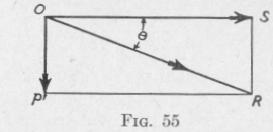70 MOTION OF A SI'IXNING BODY
shown that an added torque that retards the original precession will develop another precession that causes the spin-axis to dip (Fig. 55).
The precession of the gyro brings into play a torque which neutralizes the torque due to the overweight (Art. 36), and, so long
as the precessional velocity remains
constant, the overweight will not de
scend. If the precessional velocity be
diminished, by pushing on the frame
for example, the torque due to pre
cession will be less than sufficient to
counteract the torque due to the overweight, and the overweight will descend. If the precessional velocity be increased, the torque due to precession will be more than sufficient to counteract the torque due to the overweight, and the overweight will rise.
Air resistance and friction of bearings always produce a torque about the precession axis in the direction opposite the precession. It is for this reason that the spin-axle of a balanced gyro tends to dip.
(a) When the precessional speed of the axle of a spinning gyro is increased, the gyro is acted upon by an internal torque in opposition to the torque that produces the precession.
(b) When the precessional speed of the axle of a spinning gyro is decreased, the gyro is acted upon by an internal torque in the same direction as the torque that produces the precession.
(c) When an external torque is applied to the axle of a spinning gyro in the direction of the precession, an internal torque is developed which acts upon the gyro in opposition to the torque that produces the precession.
(d) When an external torque is applied to the axle of a spinning gyro in the direction opposite to that of the precession, an internal torque is developed which acts upon the gyro in the same direction as the torque that produces the precession.
While a spinning top is held on the palm of the hand, if the hand be moved in a horizontal circle in the direction of the precession, the top will tilt toward the vertical. " Hurry the precession, and the top rises; retard the precession and the top falls." This applies to a top spinning at an ordinary rate. If the spin-velocity be so great that the fast precessional velocity occurs (Art. 35), then if the precession be hurried, the spin-axle will tilt away from the vertical.
MOTION OF A SPINNING BODY
As soon as a moving bicycle leans to the right, the rider turns the machine about a vertical axis to the right. The spin-axes of the wheels tend to set themselves parallel to this vertical torqueaxis, thereby tilting the machine upward. Usually the bicycle will tilt beyond the vertical to the left; the same series of operations will be repeated in the opposite direction; the machine will oscillate back and forth about the position of equilibrium, and the track on the ground will be serpentine. This gyroscopic righting effect is less than the righting effect due to the tendency of the center of mass to continue in the direction in which it was already going.
The above law (a) is the basis of devices for preventing rolling of a ship in a seaway (Arts. 92-97) and for preventing the overturning of a car when running on a single rail below the car (Chap. VI). Law (b) is the basis of a device to cause a ship to roll when it is desired to get off a sand bar, or to break a passage through a frozen harbor (Art. 96).
41. Motion of the Spin-Axle Relative to the Earth. - According to the First Law of Gyrodynamics (Art. 34), the spin-axle of a gyro mounted so that the intersection of the three axes of rotation coincides with the center of mass will remain fixed in space, however the frame may be displaced, until acted upon by a torque. If the spin-axle is parallel to the axis of the earth, it will continue to be parallel while the earth rotates. In general, however, it will not remain in fixed relation to the earth. Consider a gyro with spin-axle horizontal. If it be situated at either geographic pole, it will rotate relative to the earth, making one revolution in a horizontal plane in one day. If it be situated at the equator, in the plane of the meridian, it will remain horizontal and in the meridian line. If it be situated at the equator and in the plane of the equator, it will remain in the plane of the equator but will make one revolution in one day about an axis perpendicular to the plane of the equator. At any latitude between 0° and 90°, the spin-axle will rotate relative to the earth about a vertical axis in the counter-clockwise direction as seen from above, and also will dip about a horizontal axis.
Either of these two angular motions of the gyro-axle can be prevented by the action of a suitable torque. If the torque causes a precession just equal to the vertical component of the angular velocity of the earth, then the spin-axle will turn with the earth and will maintain its position with respect to the earth, Thus
